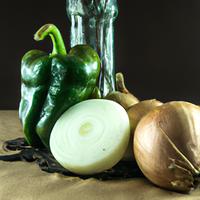
1 serving (100 grams) contains 40 calories, 1.1 grams of protein, 0.1 grams of fat, and 9.3 grams of carbohydrates.

Log this food in SnapCalorie

Nutrition Information
Calories |
59.7 | ||
|---|---|---|---|
% Daily Value* |
|||
| Total Fat | 0.1 g | 0% | |
| Saturated Fat | 0.1 g | 0% | |
| Polyunsaturated Fat | 0 g | ||
| Cholesterol | 0 mg | 0% | |
| Sodium | 6.0 mg | 0% | |
| Total Carbohydrates | 13.9 g | 5% | |
| Dietary Fiber | 2.5 g | 8% | |
| Sugars | 6.3 g | ||
| protein | 1.6 g | 3% | |
| Vitamin D | 0 mcg | 0% | |
| Calcium | 34.3 mg | 2% | |
| Iron | 0.3 mg | 1% | |
| Potassium | 217.9 mg | 4% | |
* Percent Daily Values are based on a 2,000 calorie diet. Your daily values may be higher or lower depending on your calorie needs.
Food Attributes
Source of Calories
About Onion and green peppers
Onions and green peppers are versatile, nutrient-rich vegetables commonly found in global cuisines, including Mediterranean, Latin American, and Asian cooking. Onions, available in various types like yellow, red, and sweet, are rich in antioxidants, particularly quercetin, which supports immune health. Green peppers, a variety of bell peppers, are packed with vitamin C, vitamin A, and fiber, promoting eye health, digestion, and heart function. Both vegetables are low in calories and fat, making them excellent choices for weight management and overall health. Their crisp texture and robust flavors complement stir-fries, salads, fajitas, and stews. Onions may cause gastrointestinal discomfort in sensitive individuals, while green peppers typically offer mild sweetness. Together, they provide a nutritious, flavorful base for countless dishes while supporting a balanced diet and diverse cooking traditions.



